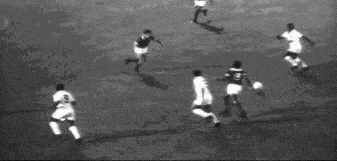
Shadow Striker FM19 Guide: Striking from the Shadows
Last year I started to cover the more exotic player roles of Football Manager. Some of the roles I highlighted, like Raumdeuter, Regista and Trequartista, have been the staples of the game for years. While Pressing Forward and Wide Targetman have only been added in the recent entries. In that respect the Shadow Striker role is not new. It was one of the original roles from 2013. Then FM did its biggest tactical revamp by dropping the old sliders and introducing the ubiquitous player roles and duties. So why write a Shadow Striker Guide? it is a role that has been around for a while. Yet I think it deserves to be celebrated for its shear usefulness. Unlike he other exotic roles, a Shadow Striker can be utilized in any tactical system and competition level in FM19. So what makes it such a universal attacking role? Shadow striker FM19 guide.

Dennis Bergkamp famously labeled himself as a shadow striker in his autobiography “Stillness and Speed: My Story”. Incidentally although stillness and speed are both excellent words to describe the hunter’s instincts required for this enigmatic role, Bergkamp was not the first or even the greatest shadow striker to grace the beautiful game. That title should probably go to the one and only, Pele.

For any football fan, no explanation is needed for Pele or what made him into a world phenomenon. Today, his name alone has come to symbolize greatness, unrivaled athleticism, grace and flair. Pele is footballing as an art-form. Likewise Pele has come to embody the whole of Brazilian ginga football style. But before he became the Brazilian ginga master of the unexpected, Pele mastered the shadow arts. The Brazilian managed to score 1281 goals, more than any striker in history, while operating mostly from the attacking midfield position and not the traditional striker role. How?
Ponta de Lança: Legacy of The Great One

The origins of Pele’s unique attacking style was as much a product of the contemporary Brazilian footballing culture as well as his own personal touch. All through Pele’s reign, from his Santos debut in 1956 until his move to New York in 1975, Brazilian football has been influenced by one formation. In Brazil, for over four decades almost every team played some form of 4-2-4 both domestically and internationally. At least on paper it was 4-2-4 but in reality Brazilians ran this formation as a very modern 4-2-3-1. A formation that has become very popular in Europe in the recent decades and revolutionized English football in the early 2000s, was widely used in Brazil some seventy years ago. And Pele was its king.
To understand how Pele’s Santos played its 4-2-4 (aka 4-2-3-1), one needs a quick crash course in Brazilian footballing terms so please bear with me. It should only take as long Pele scoring a goal.

Pele’s position, called the ponta de lança (“spearhead” in Portuguese), was essential. In Brazil players who played there were usually the team’s primary goalscorers. As the team’s “spearhead”, Pele had the important job of playing off of centre forward. He also would drop back to help the midfield duo of médio-volante (defensive midfielder) and meia-armador (midfield playmaker). In Santos’ formation, the team’s main playmaker and the player mainly responsible for playmaking was the meia-armador. As the main goalscorer, Pele played behind the three forwards: left winger (ponta-esquerda), centroavante (centre forward) and ponta-direita (right winger).
Although Pele occupied the position of an attacking midfielder, he was very aggressive in attack. This involved moving forward to play beside and sometimes beyond the striker. He did not act like a typical supporting Number10 but rather was what Football Manager describes as a Shadow Striker. According to the in-game description, “shadow striker operates as one of the team’s main goalscoring threats. Coupled with supporting forward, he aggressively pushes up into goalscoring positions as the ball moves into the final third.”
How to use Shadow Striker Effectively: FM Example

In many ways the modern game of football has become a complex game of deception and tactical feints. When an effective low defensive block is used, a stronger side will need to work hard to gain open space or any kind of numerical advantage on the field that is already compressed by the opposition. Increasingly, winning matches has become more challenging for the favourite than for the underdog. It is no different in FM virtual environment. Top managers such as Pep Guardiola and Jurgen Klopp thrive on the use of intentional overloads. They use highly specialized roles such as the inverted wingbacks and central wingers. So it is not surprising that the use of a false9 and false10 combination is as relevant today as it was seventy years ago.
Before you set any roles or instructions, the false10, our shadow striker, will need a false9 partner to operate effectively. I use the false9 moniker here in a general sense and not as the specific role in the game. Meaning you will need to partner your shadow striker with a forward playing in the forward position in front him. Any strong (physically and mentally), relatively creative player will do. I suggest you get a tall player, with good jumping reach to receive passes and hold up the ball effectively. Yet, you do not want to use a Targetman role to get the most out of a shadow striker. I am looking to play a patient calculated game of feint and riposte and not direct counter-attacks. I’ll draw opponent into the trap with my forward for my ponta de lança to strike when the gap opens.

Thus the centre forward’s role will vary depending on the attributes. If you have a very creative, technical player then an actual False9 role will be ideal. But for most teams a deep-lying forward will work wonders.
Unsurprisingly, a pairing of Shadow Striker and Deeplying-Forward will make or break a tactic that relies on a shadow forward. The two need to absolutely have good chemistry together by having attributes that complement their separate tasks well.

I will continuing with the Fiorentina example from my last Overloads article. I will use Giovanni Simeone as the DLF and Federico Chiesa as his Shadow Striker partner. The fact that I can use Chiesa to demonstrate two different roles like this not only shows the amazing versatility of the Viola wonderkid but also shows how similar raumdeuter and shadow striker are in their attribute requirements as well as in how they operate on the field.

Where Simeone is a great example of a supporting DLF due to his strong mental and physical attributes, Chiesa is known for being technical, hardworking player with an uncanny knack for finding open space (great off the ball). He is most comfortable with the ball at his feet as he is a pacey dribbler with good technique, despite his slender build and a low centre of gravity. They complement each other in how Simeone draws defenders with the perceived threat of his aggressive physicality, holds up the ball and then, while the defenders are out of position, passes it to one of the other two inside forwards or to Chiesa. In this situation, high Off the Ball and Anticipation are key for him as they will help to get into a scoring position behind the opponent defence line that was disrupted by his DLF partner.
Once you have your DLF/Shadow Striker pair sorted out, the rest of the roles should fall easily into place since they are all chosen with the goal of complementing the striker pair. They are there to create space and movement around your False10 and False9. For example, in my 4-2-3-1 system, the fullbacks play a key role in stretching the opponent horizontally, drawing the defenders and opposing fullbacks to the flanks while leaving open half-spaces for the shadow striker to exploit in the middle of the field. The DLF will compress the opponent’s defence line vertically. As result he will liberate more space between the opposing defenders and fullbacks.
With at least two wingbacks (one fullback making a late run into final third) and the central striker all occupying 3-4 opposing players, my shadow striker will be left relatively unmarked. From there he will either shoot on goal or try to bring the two inside forwards into play with a pass. I like to give him playmaker instructions to take more risks and pass directly. The “Play one-twos” trait can also come in handy here, especially if it is also present in the other three attackers.

Above is what my Brazilian-style 4-2-3-1 will look like in its defensive positioning. In attack it will essentially act like a 4-2-4. Pele role, the shadow striker, will push ahead of the DLF to act as the secondary striker. I think that using this shape is ideally suited for my needs. It allows for a lot of dynamic movement from the four attackers and the two wingbacks. The movement comes from the combinations of the two inside forwards cutting inside, centre forward dropping back, attacking midfielder running the half-spaces and the wingbacks bombing forward.
In contrast, I want my central midfielders and the two defenders to stay put. They will act as a solid defensive block in front of our goal. In this they will keep to their defensive shape and support the front four with passes . The only individual instruction I use is “stay narrower” on the left inside forward. I am not a fan of using a lot of Team Instructions. The ones I do include are all there to create a more possession-heavy, patient build up approach.
Postscript: Looking for Mr.Right
On a closing note, I would like to stress the importance of looking at the player’s attributes when choosing the candidates for the deeplying forward and shadow striker roles rather than his natural position. The following two players are far from natural in either role (one is even a defensive midfielder) but nevertheless should perform very well in my tactic. Marin Pongracic is a rare beast in that his attributes suggest that he could play as a strong supporting striker. His exceptional passing range combined with physical attributes make him into a sort of poor man’s Edin Dzeko.


On the other hand Gonzalo Higuain’s has a poacher’s eye for goal. Yet few may realize that playing him in an attacking midfield position with the supporting striker in front of him, will make him even more dangerous. Few players at the start of the game possess as many high values in the key shadow striker attributes as Gonzalo does.
They are only two recommendation out hundreds that you can probably find on your own in the game’s extensive player database. But they will hopefully inspire you in your own experimentation and in finding that next top goalscorer of the season. In the end, this article turned out more theoretical than analytical due to time constraints. I do hope to revisit the 4-2-3-1 tactic I showcased here in the near future either with Fiorentina or perhaps another Premier League team. Has this shape worked for you and how do you use it? Thanks for reading and let us know your thoughts @ Dictate The Game’s Facebook and Dictate The Game’s Twitter